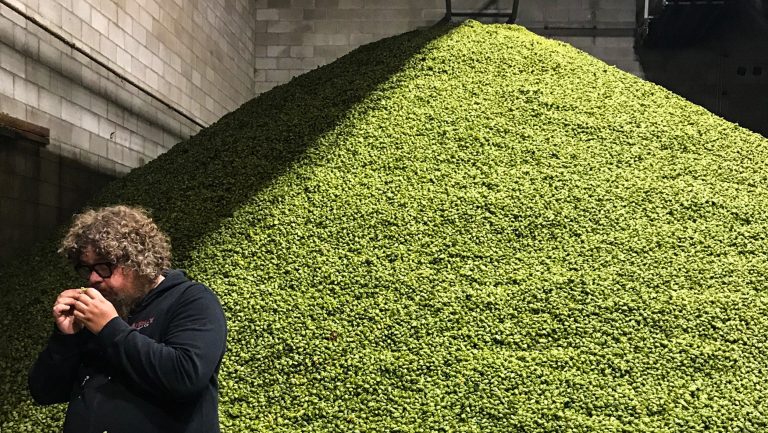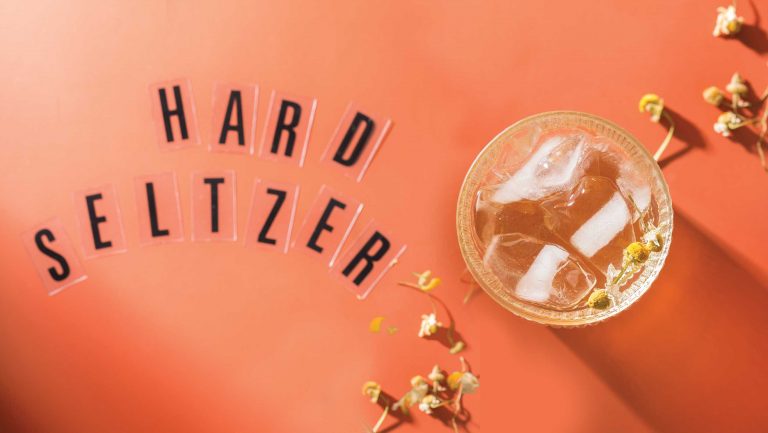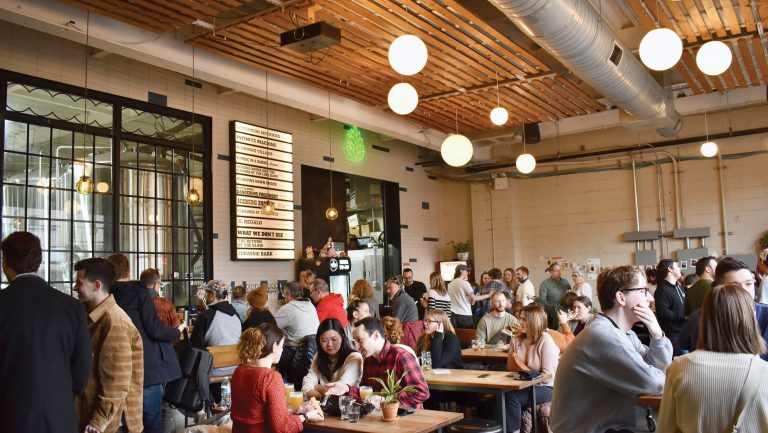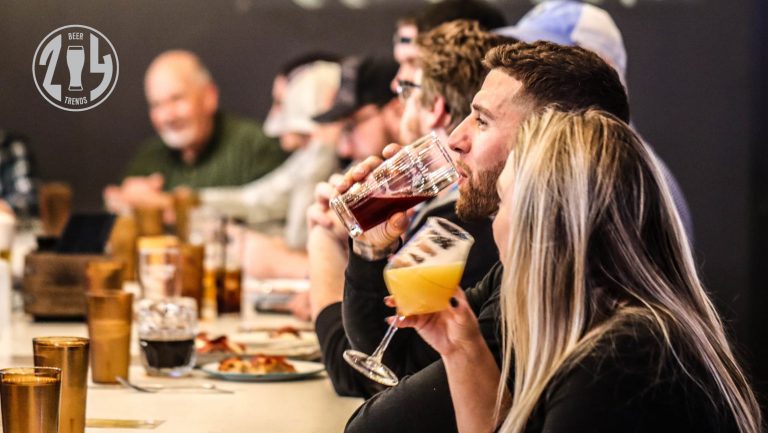With approximately 75 percent of the U.S. crop yield—78.7 million pounds of hops in 2017—coming from Yakima Valley, the annual harvest has inspired a kind of pilgrimage to Eastern Washington for many of America’s more than 6,000 breweries. Beer makers get a chance to walk the tidy rows of fields, examining plants strung up on poles high above their heads; rub fresh hop cones between their hands to expose the precious yellow lupulin that balances the sweetness of beer’s malted grains; peer into massive machines that pick, sort, dry, and package hundreds of thousands of pounds of the coveted green flowers; and breathe deeply the resulting pine-citrus-floral-herbal mélange that blankets the region from September to October.
From building fruitful relationships and negotiating contracts to influencing the very future of beer’s most expensive, aromatic raw ingredient, there are numerous ways that breweries can benefit. SevenFifty Daily spoke with a brewer, a hop breeder, and a farmer to learn more about why it’s so important for producers to set aside the time and money to experience the hop harvest in person.
Building Relationships
Budgeting the funds to attend the harvest is the biggest piece of hop-related advice Ben Smith, the head brewer at Surly Brewing Company in Minneapolis, offers new and small brewers. “It can be an expensive trip,” he says, “but it’s well worth it because you’re not only picking the hops you’re going to use but also creating the connections with your supplier, meeting your farmers, seeing everything firsthand. I think it makes a huge difference in those relationships.”

Don’t miss the latest drinks industry news and insights. Sign up for our award-winning newsletters and get insider intel, resources, and trends delivered to your inbox every week.
Smith should know; Surly is famous for hop-heavy beers like Furious, its flagship IPA, which is bursting with citrus notes, thanks to hops like Cascade, Simcoe, and Amarillo. On average, Smith estimates, the company uses 3 pounds of hops per barrel of beer (31.5 gallons, or 248 pints). That’s a relatively high ratio given the pricey nature of hops, which range from $5 or so per pound up to $18 or more. That adds up quickly when you brew 94,000 barrels of beer, as Surly did in 2017.
“You’re essentially contracting for hundreds of thousands of dollars—if not millions of dollars—of product, maybe two to three years before you’re ever going to use it,” Smith says, “and the market’s always changing, but the better the relationships you have with farmers and suppliers, the easier it is to get what you need out of it.”

Setting Contracts
Contracts, for the most part, facilitate how hops change hands. Riskier spot purchases, however, are used to fill in gaps or—in the case of many small brewers who either lack the leverage or prefer to stay nimble—may be used in lieu of contracts. “If it’s a good year and you don’t have hops on contract,” Smith says, “you might end up being able to get them cheaper than someone who did have them on contract, but it’s kind of like playing the stock market.” (Notably, the supply of hops finally outpaced demand in 2017—and this has put pressure on the supply chain and may force growers and suppliers to pump the brakes on further acreage.)
The owners of Surly, the 49th largest U.S. brewery, based on sales volume last year, would never have opened a new facility in 2014 triple the size of their original space without first making sure they had the hops needed to keep making the beer they planned to make. The company signed contracts then that carried them through the present, and it’s involved in contracting again through 2021.
Surly has a little wiggle room with some of its permanent beers, like Furious, whose blend of hops can be tweaked within a range of acceptable consistency as hops go through slight variations harvest by harvest, but with others, like Extra Citra, Smith says, “We’ve painted ourselves into a corner because that’s a 100 percent Citra-hopped beer, so we are dependent on the fact that we can source those hops in the correct amounts and hope that the crop itself [each year] is going to be good.”
Growers appreciate the security of contracts, too. “Farmers don’t typically plant varieties on a whim and hope a brewer or hop broker will purchase them,” says Paul Merritt, who is employed by Hopsteiner, an international grower, processor, and supplier with a strong presence in Yakima, as manager of Golden Gate Hop Ranches. “Contracts are the driving force for what gets planted based on supply-and-demand needs. It’s a considerable amount of money to establish, to farm, and then not know for sure if you have sales for that hop.”
Ensuring Consistency
While most brewers get a kick out of experimenting, beer drinkers still expect a lot of consistency, and the best way to ensure consistency is to examine the hops personally. “You can look at chemical analysis,” says Smith. “But honestly, it’s probably about 80 percent sensory, where you’re actually looking at the hops, rubbing them, smelling them, making sure they taste right in relation to the flavor profile you’re looking at.” Smith points out that Citra hops from four different farms are going to be relatively similar, albeit with some noticeable differences. Therefore, he says, “it’s a big part of our experience on the brewing side to make sure we’re going out there and picking lots that, year over year, allow us to make the same beers that taste the same despite having those varietal differences from harvest and weather and growing season.”
Controlling Quality
Another benefit of showing up at the harvest is the opportunity to vet the production of your hops. Nicholi Pitra, a hop breeder for Hopsteiner, explains that not all growers or processors maintain the same level of quality or take the same pride in their work. “Some places keep their [facilities] up to date,” he says. They keep birds from interfering with their drying areas and prioritize operations to optimize hop processing. “This is stuff you’re literally dropping into your artwork, your product, and so to be able to see that side of things is super important.”
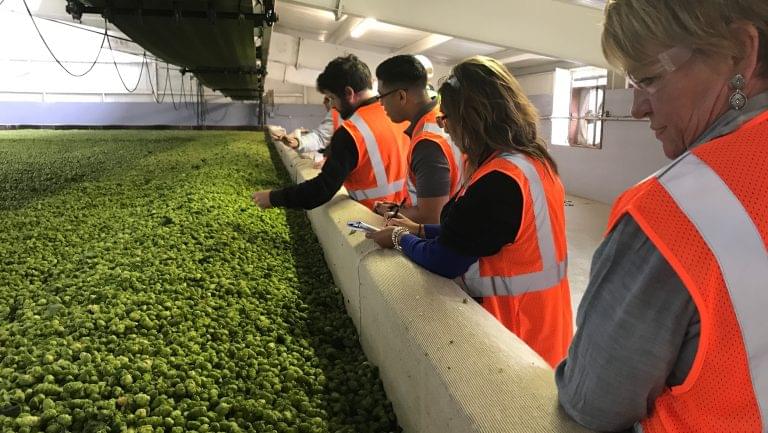
To guide newcomers in the right direction, Merritt recommends that they look for suppliers with good certifications—like organic or GLOBALG.A.P.—that demonstrate on-farm food safety and sustainability. “It may not always get us a sale with a customer,” he says, “but it helps farmers look at their operations and what they’re doing a little more in-depth. Maybe they could be doing things a little better than how grandpa did it for 100 years.”
Influencing Breeding
Because of the need to develop plants that are vigorous, high yielding, and resistant to diseases, a breeder like Pitra will typically take at least 10 years to test a hop and bring it from crossbreeding to full-scale production. There are only two primary ways to speed things up: weeding out deleterious traits while selecting for positive ones early on through molecular breeding—using mixed linear modeling to compare observable traits like “long cones” or “big leaves” with qualities that can be sussed out from the genome through a leaf-cutting at the seedling stage to determine, for example, whether a particular plant is male or a desired flower-producing female, whether its hops will produce high levels of advantageous alpha acids, whether the plant may be drought-resistant—or getting a brewer’s insight on the sensory side.
In other words, Pitra can identify a hearty plant, but he can’t necessarily say if it will translate well to a beer in the drinker’s hand. “I’m not a brewer,” he says. “I can’t see this vision or find this trend. [A brewer can say,] ‘Wow, this one smells like caramel apples,’ and I’m like, ‘Oh, I liked it because it looks like it’s going to yield 20 bales an acre.’” Those two things put together allow Pitra to make a decision about what gets developed for the market. He needs to incorporate the brewer’s vision into what he’s doing so that both can achieve their goals.


Dispatch
Sign up for our award-winning newsletter
Don’t miss the latest drinks industry news and insights—delivered to your inbox every week.
Adam H. Callaghan is the editor of Eater Seattle and a freelance writer and editor specializing in food, fermentation, beverages, and travel. He hails from Maine and lives in Seattle with his partner, Stasia, and a variety of bubbling Ball jars.

